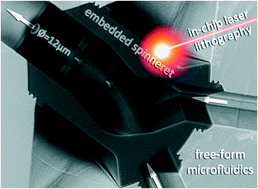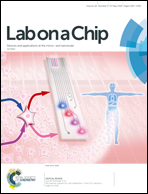3D nanofabrication inside rapid prototyped microfluidic channels showcased by wet-spinning of single micrometre fibres†
Abstract
Microfluidics is an established multidisciplinary research domain with widespread applications in the fields of medicine, biotechnology and engineering. Conventional production methods of microfluidic chips have been limited to planar structures, preventing the exploitation of truly three-dimensional architectures for applications such as multi-phase droplet preparation or wet-phase fibre spinning. Here the challenge of nanofabrication inside a microfluidic chip is tackled for the showcase of a spider-inspired spinneret. Multiphoton lithography, an additive manufacturing method, was used to produce free-form microfluidic masters, subsequently replicated by soft lithography. Into the resulting microfluidic device, a three-dimensional spider-inspired spinneret was directly fabricated in-chip via multiphoton lithography. Applying this unprecedented fabrication strategy, the to date smallest printed spinneret nozzle is produced. This spinneret resides tightly sealed, connecting it to the macroscopic world. Its functionality is demonstrated by wet-spinning of single-digit micron fibres through a polyacrylonitrile coagulation process induced by a water sheath layer. The methodology developed here demonstrates fabrication strategies to interface complex architectures into classical microfluidic platforms. Using multiphoton lithography for in-chip fabrication adopts a high spatial resolution technology for improving geometry and thus flow control inside microfluidic chips. The showcased fabrication methodology is generic and will be applicable to multiple challenges in fluid control and beyond.



 Please wait while we load your content...
Please wait while we load your content...